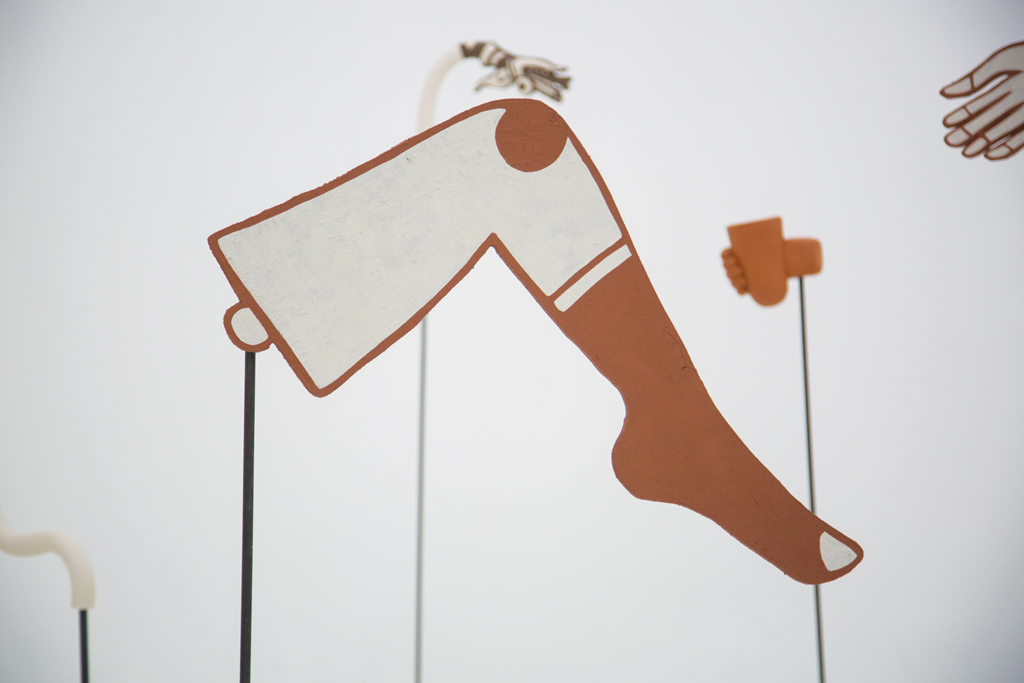[ad_1]
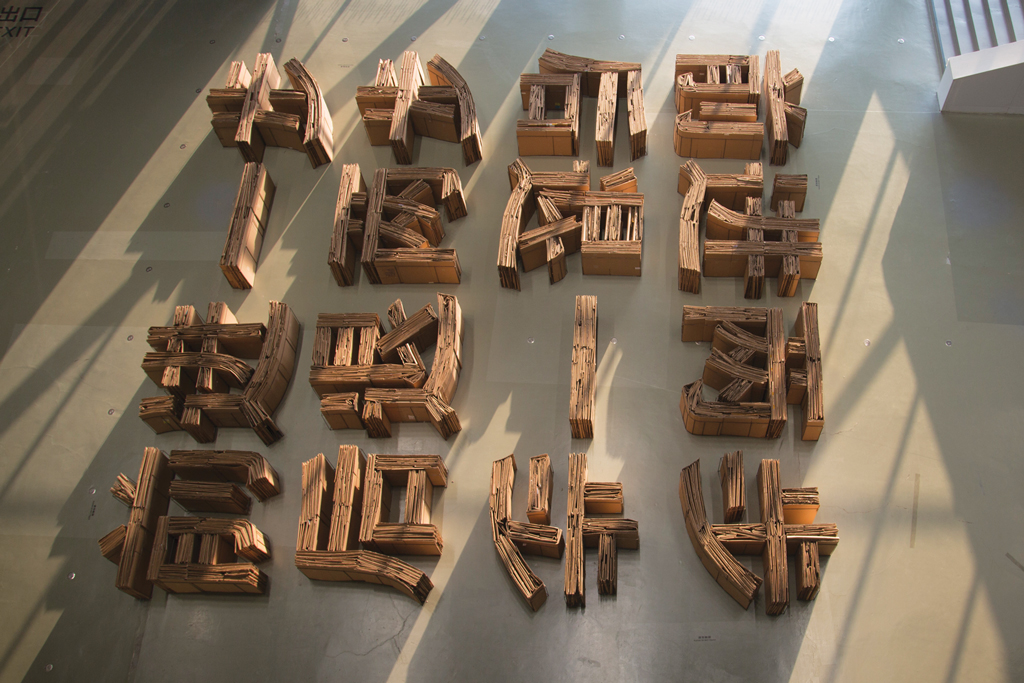
Enrique Ježik, In Hemmed-in Ground, 2018, steel structure with recycled cardboard, 30¼ inches x 37 feet, 8¾ inches x 37 feet, 8¾ inches.
JIANG WENYI/COURTESY THE ARTIST AND HILARIO GALGUERA GALLERY, MEXICO CITY/COMMISSIONED BY THE 12TH SHANGHAI BIENNALE
In the cavernous entry hall of Shanghai’s Power Station of Art, visitors encountered what appeared to be waist-high piles of discarded cardboard. Only after ascending to a second-floor balcony and viewing it from above did they realize that Argentinian artist Enrique Ježik’s mammoth installation spelled out, in Chinese characters, the phrase “one step forward, two steps back; two steps forward, one step back.” The message formed an apt introduction to the 12th edition of the Shanghai Biennale, which takes its title, “Proregress,” from a 1931 poem by American modernist e. e. cummings. Here, the word referred to the world’s current social and political landscape, with numerous countries sliding backward in a reaction against progressive movements.
Ježik, who lives and works in Mexico City, was a hometown pick by the organizer of “Proregress,” Cuauhtémoc Medina, who is chief curator of that city’s Museo Universitario de Arte Contemporanea—and he wasn’t the only such artist. Medina, who, along with curators María Belén Sáez de Ibarra from Colombia, Yukie Kamiya from Japan, and Wang Weiwei from China, selected 67 artists and collectives from 26 countries, brought with him the largest grouping of art from Latin America ever to be seen in China. It makes sense for “Proregress”: several Latin American countries are struggling with failing economies, and Brazil has just elected a president with authoritarian tendencies.
A Latin American artist was responsible for one of the most visible artworks in the biennial, and one of the most political: Streaming down the Power Station’s five-story atrium was Chilean artist Voluspa Jarpa’s Monumenta (2018), a giant mobile made out of declassified documents (printed as transparencies on plexiglass) detailing U.S. intelligence agencies’ incursions into Latin America.
Off the atrium on the first floor, one entered a warren of video installations where artists continued the theme of lives upended and dreams curtailed by Western notions of progress. Christoph Draeger and Heidrun Holzfeind, respectively Swiss and Austrian, teamed up to create The Auroville Project, a fascinating look at a utopian community in Southeast India founded in 1968 and still operating today. Photographs and artifacts surrounded a geodesic dome housing videos capturing the society’s universalist outlook and educational programs. Peruvian artist Claudia Martínez Garay contributed nuqa kausa kusaq qhepaykitapas/i will outlive you (2017), a haunting video filmed in adobe dwellings accompanied by idiosyncratic clay figures and shapes, displayed as they might be in an ethnographic museum.
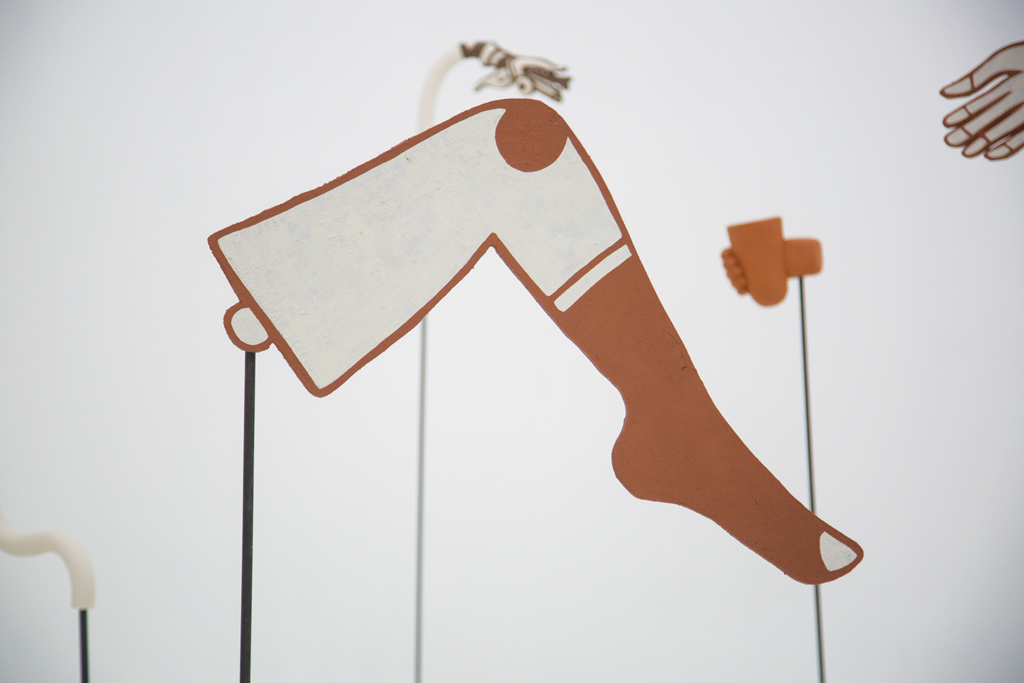
Claudia Martínez Garay, … imaywanpas quidakuwakmi … / … but you can stay with my stuff … (detail), 2017, ceramic and paintings, dimensions variable.
JIANG WENYI/COURTESY GRIMM GALLERY, AMSTERDAM
Upstairs, installations veered from one political crisis to the next, as biennials tend to do these days; the standout works among them managed to join aesthetic innovations to thoughtful commentary. For example, In Search of Vanished Blood (2012), by master Indian artist Nalini Malani, was a complete video environment that depicted dualities (nature vs. war, female vs. male) in vivid hand-drawn animations and footage of projected text streaming over women’s bodies. In their three-channel video, The Great Silence (2014), the team of Jennifer Allora & Guillermo Calzadilla from Puerto Rico humorously examined the intentions of the Arecibo Observatory in Esperanza, Puerto Rico, to make contact with extraterrestials from the viewpoint of a talking parrot who lives in the surrounding Rio Abajo forest. Japanese artist Chiba Masaya charmed his way into the mix with his paintings of the interior of his studio, filled with papier-mâché objects he creates from ephemera and debris he gathers daily in the streets of Yokohama. Much more politically charged and graphically arresting were Philippines artist Kiri Dalena’s “portraits” of political activists in their homes, their faces covered with white plaster masks to protect their anonymity.
But the artist who best captured the theme of “Proregress” was Michael Rakowitz, an artist of Iraqi descent living in Chicago, with his installation, The Invisible Enemy Should Not Exist. (Recovered, Missing, Stolen Series), 2007 to the present. Displayed in numerous glass vitrines were Rakowitz’s miniature papier-mâché re-creations of antiquities looted from the National Museum of Iraq in Baghdad in the aftermath of the 2003 U.S. invasion. On the surrounding walls were his hyperrealistic cartoons narrating the story of the many players involved in the looting, from the head of the museum to U.S. military leaders; it was a prime example of American aspirations to spark progress running counter to the preservation of culture.
A very literal, Sisyphean visualization of “Proregress” was Francis Alÿs’s Rehearsal I (1999–2004), a video of a red VW Beetle struggling to ascend a sandy hill, only to keep sliding back down. The work, which has been exhibited many times, can seem like a facile metaphor for the ambivalent relationship of third world countries to linear notions of modernism, but in the context of this biennial, it found new relevance.
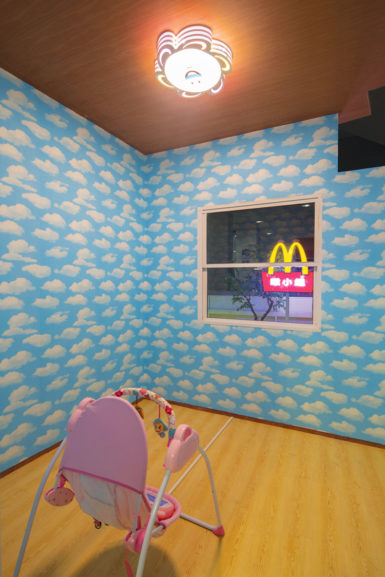
Jiu Society, A Community Estate Project, 2018, mixed-media installation, dimensions variable.
JIANG WENYI/COURTESY VANGUARD GALLERY, SHANGHAI
The relevance of “Proregress” to China, however, with its enviable GDP, seemed a bit of a stretch, especially in Shanghai. All around the city, there seemed to be nothing but progress, particularly in the art scene, which has witnessed an unprecedented growth of private museums and art fairs. Around the time the biennial opened, Shanghai unveiled two art fairs: Art 021 and West Bund Art Fair. A stellar Louise Bourgeois show opened at the Long Museum, a Francis Alÿs exhibition opened at the Rockbund Art Museum, Maurizio Cattelan collaborated with Gucci at the Yuz Museum, and Thomas Hirschhorn unveiled a huge installation at the Ming Art Museum. To cap things off, Shanghai collector Qiao Zhibing inaugurated Tank Shanghai, a museum complex installed in former oil tanks on the banks of the Huangpu River, where two artists in the biennial staged off-site events.
Then again, an ominous shadow loomed in the person of President Xi Jinping, who was in town for the China International Import Expo. In the past two years, President Xi has unleashed a slate of repressive measures, including the imprisonment of nearly a million Uyghur citizens in Xinjiang province and the arrest of dozens of internet activists and human rights lawyers. Rumors abounded in Shanghai that it might have been due to Xi’s presence there that the artist selections at the biennial were not finalized until two days before the opening. With those rumors came attendant buzz of censorship. Whereas artists’ contributions from other regions freely addressed issues such as post-colonialism, immigration, climate change, and politics, Chinese artists came across as reticent on current events.
Nevertheless, the Biennale remains a great place to discover emerging Chinese artists. This time around, several were given the run of the Power Station’s third floor. Jiu Society, a collaborative team of three Shenzhen artists—Fang Di, Ji Hao, and Jin Haofan—turned their gallery into a model home rental display with A Community Estate Project (2018), a satire of China’s real estate boom. Complete with a duo of sales agents, the installation included a miniature model of the real estate development and a faux apartment with gilded furniture and a widescreen TV. Close by, another bedroom setup featured a video of an imaginary game show, testing contestants on their knowledge of the development of Shanghai’s art scene. Titled Not As Trivial As You Think (2018), it was the work of the duo C+G, Hong Kong artists Clara Cheung and Cheng Yee Man. Another Hong Kong artist, Samson Young, was responsible for the remarkable Muted Situation #22: Muted Tchaikovsky’s 5th (2018), a single-channel video installation with 12-channel sound of an orchestra playing the classical composition, but all music was muted, allowing for only the sounds of violin and strings being stroked and drums being struck.
Huang Jing Yuan created a full environment with her work, The Right to Write (2016–18). In this homage to storytelling, the artist paired Chinese street signage, monumental realist paintings, a floor made of layers of bubble wrap, and an animation depicting different modes of narrative production, from a naive fairytale to a history of Thomas Edison’s light bulb. In the final space of this multipart wooden structure, Huang provided visitors a writing desk and paper to contribute their own stories.
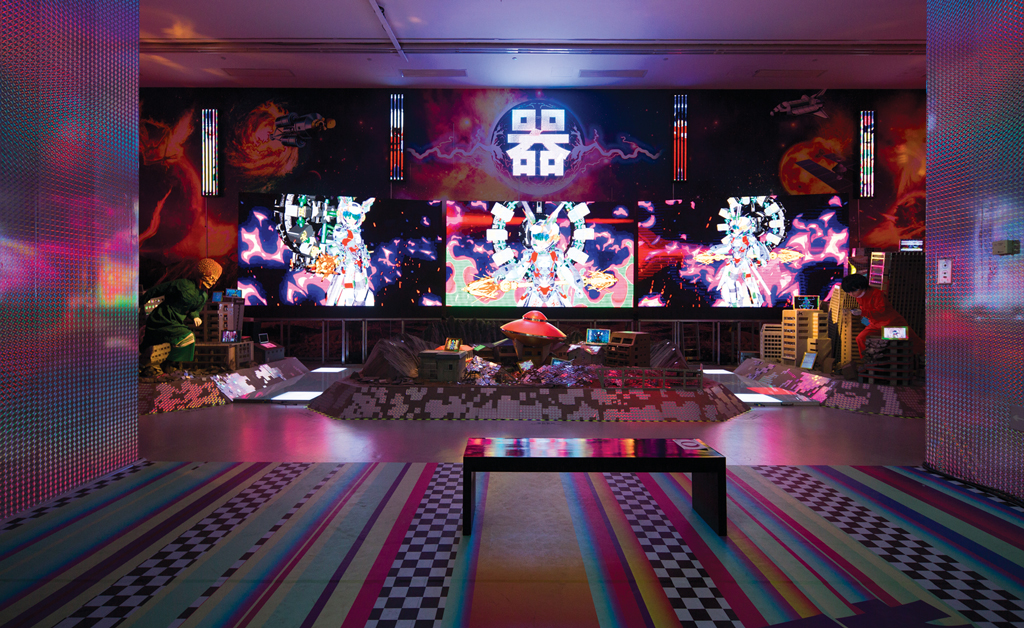
Lu Yang, Material World Knight, 2018, video installation, dimensions variable.
JIANG WENYI
Absorbing as they were, none of these works seemed particularly pointed or critical of any aspect of Chinese life, though The Right to Write might be interpreted as a call to self-empowerment. Their presence, while welcome additions to a show that must feature at least a few Chinese artists, watered down the overall theme. In stark contrast, Lu Yang’s multimedia installation Material World Knight (2018) was worth the show’s price of admission.
Material World Knight wove together references to the film Mars Attacks, Japanese anime, and the latest information on biotechnology. Mural-size monitors broadcasted animations about superheroes and exoskeleton robotics; arcade machines playing fully operational video games lined the walls. In the center of the floor were three sprawling architectural models of cities in states of destruction, post-apocalyptic visions with an alien spacecraft landing in the middle of one. LED signs making announcements in Chinese hung near the ceiling, and Japanese pop music was piped in. It all added up to a mesmerizing bombardment of the senses, a frenetic sci-fi vision of the future.
Medina’s Shanghai Biennale could have used more of Lu Yang’s infectious energy. Its maze of dark screening rooms was too often unrelentingly somber. But maybe that’s the point: seen against the background of Shanghai’s ebullient mood, “Proregress” threw problematic world affairs into high relief, and made the ebullience feel like fantasy.
A version of this story originally appeared in the Spring 2019 issue of ARTnews on page 106 under the title “12th Shanghai Biennale.”
[ad_2]
Source link

